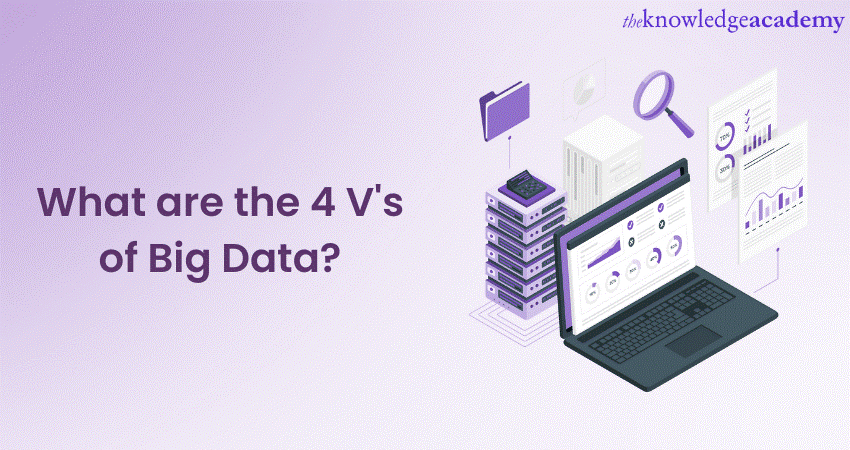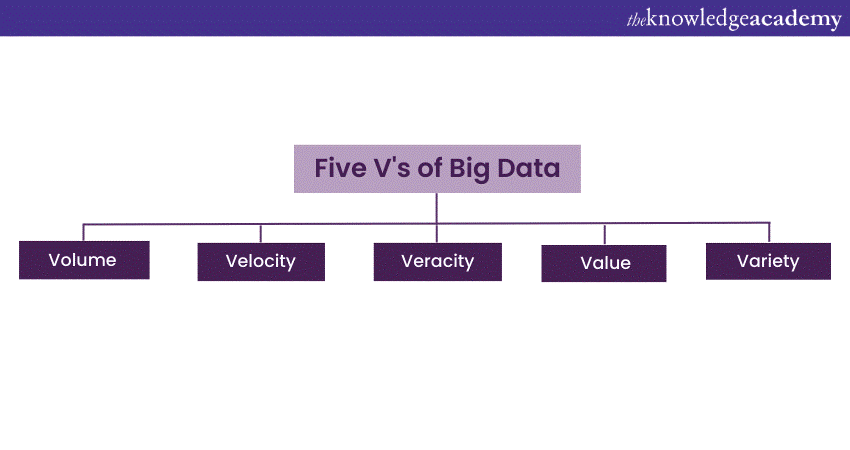We may not have the course you’re looking for. If you enquire or give us a call on +49 8000101090 and speak to our training experts, we may still be able to help with your training requirements.
Training Outcomes Within Your Budget!
We ensure quality, budget-alignment, and timely delivery by our expert instructors.

Have you ever wondered what makes data "big"? In today's data-driven world, understanding the 4 V's of Big Data is crucial for harnessing its potential. These characteristics—Volume, Velocity, Variety, and Veracity—define the essence of Big Data.
In this blog, we’ll explore the 4 V's of Big Data in detail and reveal why they are so important. We’ll also discuss a fifth V that often goes unnoticed but is equally significant. Let's embark on this journey to uncover how mastering these concepts can transform your approach to data and drive your success.
Table of Contents
1) Understanding Big Data in Detail
2) What are the 4 V’s of Big Data?
a) Volume
b) Velocity
c) Variety
d) Veracity
3) What is the Fifth V?
4) Conclusion
Understanding Big Data in Detail
Big Data refers to the immense and complex data sets generated from various sources like social media, sensors, digital devices, and more. Its vast volume, rapid velocity, and diverse variety necessitate advanced tools and techniques for processing and analysis. Big Data helps uncover patterns, trends, and associations, particularly in fields like business, healthcare, and technology.
By leveraging Big Data, organisations can make data-driven decisions, enhance operational efficiency, and gain competitive advantages. The continuous growth of data underscores the importance of robust infrastructure and innovative solutions to harness its full potential.
What are the 4 V’s of Big Data?
Big Data is generally defined by four major characteristics: Volume, Velocity, Variety and Veracity. Let’s discuss all 4 V’s of Big Data in detail:
Volume
As we know, the first characteristic of Big Data is its Volume. Trillions of gigabytes of data are created worldwide every day, and the numbers will only rise in the years to come. Most of this massive quantity of data generated daily is due to the widespread use of mobile phones.
Text, photos, videos and applications create lots of data every day, and it will only increase with mobile phone use in the coming years. As the Volume of data sees exponential growth, new Database Management Systems and IT employees will be needed to handle it. As a result, millions of new IT jobs are expected to open in the coming years – thanks to the Volume of Big Data.
Example: Social media platforms like Facebook generate petabytes of data daily through posts, comments, and multimedia uploads.
Velocity
Velocity, or speed as many would call it, is the second characteristic of Big Data. It refers to the unprecedented speed at which data is generated and processed. The data is processed instantaneously if you send a text or post anything on social media such as Facebook, Twitter or Instagram.
Processing and surfacing information once was a time-consuming process, but with the advent of the internet – it takes next to no time. However, this is not just because of the internet but also of the existence of data. The more the data is created, the more methods are required to handle it, and the more data is monitored – thereby creating a cycle.
Example: Financial markets require real-time data processing to execute trades and manage risk effectively.
Variety
The first and second characteristics of Big Data correlate with the third character, the Variety of Big Data. As we know, data is large in volume and fast to process – and at the same time, data comes in many types. Organisations and individuals generate and process data according to their specific needs, ensuring a wide variety of data on the planet.
IT solutions are available to almost all sectors, from business to banking and the medical to the sports industry. Nearly every organisation in every sector keeps a database, contributing to a wide Variety of data. When the internet reaches the farthest corners of the world, the Variety of data will only increase.
Example: Emails, social media posts, videos, and sensor data all represent different forms of data collected by companies.
Veracity
The final characteristic attributed to Big Data is its Veracity. Veracity can be defined as conformity to facts or accuracy, and it refers to the element of accuracy that data possesses. The Veracity of Big Data refers to the data's trustworthiness and denotes the data's accuracy and quality.
Data quickly becomes outdated, and with its abundance, it is tricky to determine the authenticity of everything you see. This is why many upper-level businesspeople do not dare make decisions only on data. This also grants impetus to data Scientists and IT Professionals to organise and process the right data so that it can be used correctly. The higher the veracity, the more important the data is as it is set to be analysed and converted to meaningful information.
Example: Customer feedback data may be filled with inconsistencies, biases, or inaccuracies, requiring validation and cleansing to ensure reliability.
Become a certified Big Data and Hadoop Solutions Architect Course and unlock advanced career opportunities in Big Data Analytics!
What is the Fifth V?
While the four V, as mentioned earlier, are the most common characteristics associated with Big Data, a fifth V often goes under the radar. The fifth important element of Big Data is its Value or significance. Data, when organised and processed in the right way, can be converted into valuable information.
In the modern data-driven ecosystem, organisations that do not create a data strategy will likely fall behind their counterparts. Organisations that use their data profit much more as data provides important understanding and context of customers. Contextualised data provides insight into customer behavioural patterns, how to optimise business operations and to improve service delivery.
Regardless of how it is used, the fact that data creates value when used correctly is a very important element. This is why organisations, regardless of size or industry, should adopt a data strategy to ensure that they are profiting from the valuable data.
Example: Retail companies analyse customer purchase data to identify trends and personalise marketing strategies, thereby increasing sales and customer satisfaction.

Conclusion
Mastering the 4 V's of Big Data—Volume, Velocity, Variety, and Veracity—plus the hidden gem, Value, is your ticket to transforming raw data into powerful insights. Embrace these elements to supercharge your data strategy, outpace competitors, and thrive in today’s data-driven world. Unleash the true potential of your data and watch your success story unfold!
Become an expert in Big Data by signing up for our Big Data and Analytics Training - sign up now!
Frequently Asked Questions

The 5 V’s of Big Data are:
1) Volume: Amount of data generated
2) Velocity: Speed of data processing
3) Variety: Different types and sources of data
4) Veracity: Accuracy and reliability of data
5) Value: Insights and significance derived from data

While all V's are crucial, “Value” is often considered the most important. It represents the insights and actionable information derived from Big Data, driving decisions and strategies that significantly impact organisational success.

The Knowledge Academy takes global learning to new heights, offering over 30,000 online courses across 490+ locations in 220 countries. This expansive reach ensures accessibility and convenience for learners worldwide.
Alongside our diverse Online Course Catalogue, encompassing 17 major categories, we go the extra mile by providing a plethora of free educational Online Resources like News updates, Blogs, videos, webinars, and interview questions. Tailoring learning experiences further, professionals can maximise value with customisable Course Bundles of TKA.

The Knowledge Academy’s Knowledge Pass, a prepaid voucher, adds another layer of flexibility, allowing course bookings over a 12-month period. Join us on a journey where education knows no bounds.

The Knowledge Academy offers various Big Data and Analytics Training, including Big Data Analysis, Big Data Architecture Training, Big Data and Hadoop Solutions Architect and Big Data Analytics & Data Science Integration Course. These courses cater to different skill levels, providing comprehensive insights into Big Data Analyst Job Description.
Our Data, Analytics & AI Blogs cover a range of topics related to Big Data, offering valuable resources, best practices, and industry insights. Whether you are a beginner or looking to advance your Data Analytics skills, The Knowledge Academy's diverse courses and informative blogs have got you covered.
Upcoming Data, Analytics & AI Resources Batches & Dates
Date
 Big Data Architecture Training
Big Data Architecture Training
Fri 24th Jan 2025
Fri 28th Mar 2025
Fri 23rd May 2025
Fri 25th Jul 2025
Fri 26th Sep 2025
Fri 28th Nov 2025







 Top Rated Course
Top Rated Course



 If you wish to make any changes to your course, please
If you wish to make any changes to your course, please


